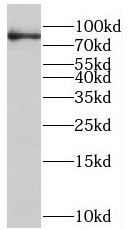Products
PTPN22 antibody
| Synonyms: | Tyrosine-protein phosphatase non-receptor type 22|Hematopoietic cell protein-tyrosine phosphatase 70Z-PEP|Lymphoid phosphatase (LyP)|PEST-domain phosphatase (PEP)|PTPN22|PTPN8 antibody | ||
| Catalogue No.: | FNab06936 | Reactivity: | Human, Mouse, Rat |
| Host: | Rabbit | Tested Application: | ELISA, WB, IHC, IP |
| Clonality: | polyclonal | Isotype: | IgG |
| Size | Price |
|---|---|
| 100µg | Inquiry |
- SPECIFICATIONS
- FIGURES
- CONDITIONS
- FAQS
- Product Name
- PTPN22 antibody
- Catalogue No.
- FNab06936
- Size
- 100μg
- Form
- liquid
- Purification
- Immunogen affinity purified
- Purity
- ≥95% as determined by SDS-PAGE
- Clonality
- polyclonal
- Isotype
- IgG
- Storage
- PBS with 0.02% sodium azide and 50% glycerol pH 7.3, -20℃ for 12 months(Avoid repeated freeze / thaw cycles.)
- Immunogen
- protein tyrosine phosphatase, non-receptor type 22(lymphoid)
- Alternative Names
- Tyrosine-protein phosphatase non-receptor type 22|Hematopoietic cell protein-tyrosine phosphatase 70Z-PEP|Lymphoid phosphatase (LyP)|PEST-domain phosphatase (PEP)|PTPN22|PTPN8 antibody
- UniProt ID
- Q9Y2R2
- Observed MW
- 79-95 kDa
- Tested Applications
- ELISA, WB, IHC, IP
- Recommended dilution
- WB: 1:200-1:2000; IP: 1:200-1:1000; IHC: 1:20-1:200
 Jurkat cells were subjected to SDS PAGE followed by western blot with FNab06936(PTPN22 antibody) at dilution of 1:600
Jurkat cells were subjected to SDS PAGE followed by western blot with FNab06936(PTPN22 antibody) at dilution of 1:600
 IP Result of anti-PTPN22 (IP:FNab06936, 4ug; Detection:FNab06936 1:300) with Jurkat cells lysate 3080ug.
IP Result of anti-PTPN22 (IP:FNab06936, 4ug; Detection:FNab06936 1:300) with Jurkat cells lysate 3080ug.
 Immunohistochemistry of paraffin-embedded human lymphoma using FNab06936(PTPN22 antibody) at dilution of 1:50
Immunohistochemistry of paraffin-embedded human lymphoma using FNab06936(PTPN22 antibody) at dilution of 1:50
- Background
- Acts as negative regulator of T-cell receptor(TCR) signaling by direct dephosphorylation of the Src family kinases LCK and FYN, ITAMs of the TCRz/CD3 complex, as well as ZAP70, VAV, VCP and other key signaling molecules(PubMed:16461343, PubMed:18056643). Associates with and probably dephosphorylates CBL. Dephosphorylates LCK at its activating 'Tyr-394' residue(PubMed:21719704). Dephosphorylates ZAP70 at its activating 'Tyr-493' residue(PubMed:16461343). Dephosphorylates the immune system activator SKAP2(PubMed:21719704). Positively regulates toll-like receptor(TLR)-induced type 1 interferon production(PubMed:23871208). Promotes host antiviral responses mediated by type 1 interferon(By similarity). Regulates NOD2-induced pro-inflammatory cytokine secretion and autophagy(PubMed:23991106).
How many times can antibodies be recycled?
First, usually it's not suggested to recycle antibodies. After use, buffer system of antibodies has changed. The storage condition of recycled antibodies for different customers also varies. Thus, the performance efficiency of recycled antibodies can’t be guaranteed. Besides, FineTest ever conducted the antibody recycling assay. Assay results show recycling times of different antibodies also varies. Usually, higher antibody titer allows more repeated use. Customers can determine based on experimental requirements.
Notes: After incubation, we recycle rest antibodies to centrifuge tube and store at 4℃. High titer antibodies can be stored for a minimum of one week. Reuse about three times.
What are components of FineTest antibody buffer?
Components of FineTest antibody buffer are usually PBS with proclin300 or sodium azide, BSA, 50% glycerol. Common preservative is proclin300 or sodium azide, which is widely applied in the lab and industry.
How about the storage temperature and duration of FineTest antibodies?
Most antibodies are stored at -20℃. Directly-labeled flow cytometry antibodies should be stored at 2 - 8℃. The shelf life is one year. If after sales issues for purchased antibodies appear, return or replacement is available. Usually, antibodies can be still used after the one-year warranty. We can offer technical support services.
Is dilution required for FineTest antibodies? What’s the dilute solution?
Directly-labeled flow cytometry antibodies are ready-to-use without dilution. Other antibodies are usually concentrated. Follow the dilution ratio suggested in the manual. Dilute solution for different experiments also varies. Common antibody dilution buffers are acceptable(e.g. PBST, TBST, antibody blocking buffer).
How to retrieve antibodies for immunohistochemistry?
Common retrieval buffers: Tris-EDTA Buffer(pH 9.0); Citrate Buffer(pH 6.0)
Heat induced antibody retrieval:
Method 1: Water-bath heating: Put the beaker with retrieval buffer and slide in the boiling water bath. Keep the boiling state for 15min. Naturally cool to room temperature;
Method 2: Microwave retrieval: Put the beaker with retrieval buffer and slide in the microwave oven. Heat at high power for 5min, Switch OFF for 3min, Heat at medium power for 5min. Naturally cool to room temperature.
How to choose secondary antibodies?
(1) Secondary antibodies react with primary antibodies. Thus, secondary antibodies should be against host species of primary antibodies. E.g. If the primary antibody is derived from rabbit, the relevant secondary antibody should be against rabbit. E.g. goat anti rabbit or donkey anti rabbit.
(2) Choose secondary antibody conjugates according to the experimental type, e.g. ELISA, WB, IHC etc. Common enzyme conjugated secondary antibodies are labelled by HRP, AP etc. Fluorescin or dye labelled secondary antibodies are applied in immunofluorescence and flow cytometry(e.g. FITC, Cy3).
